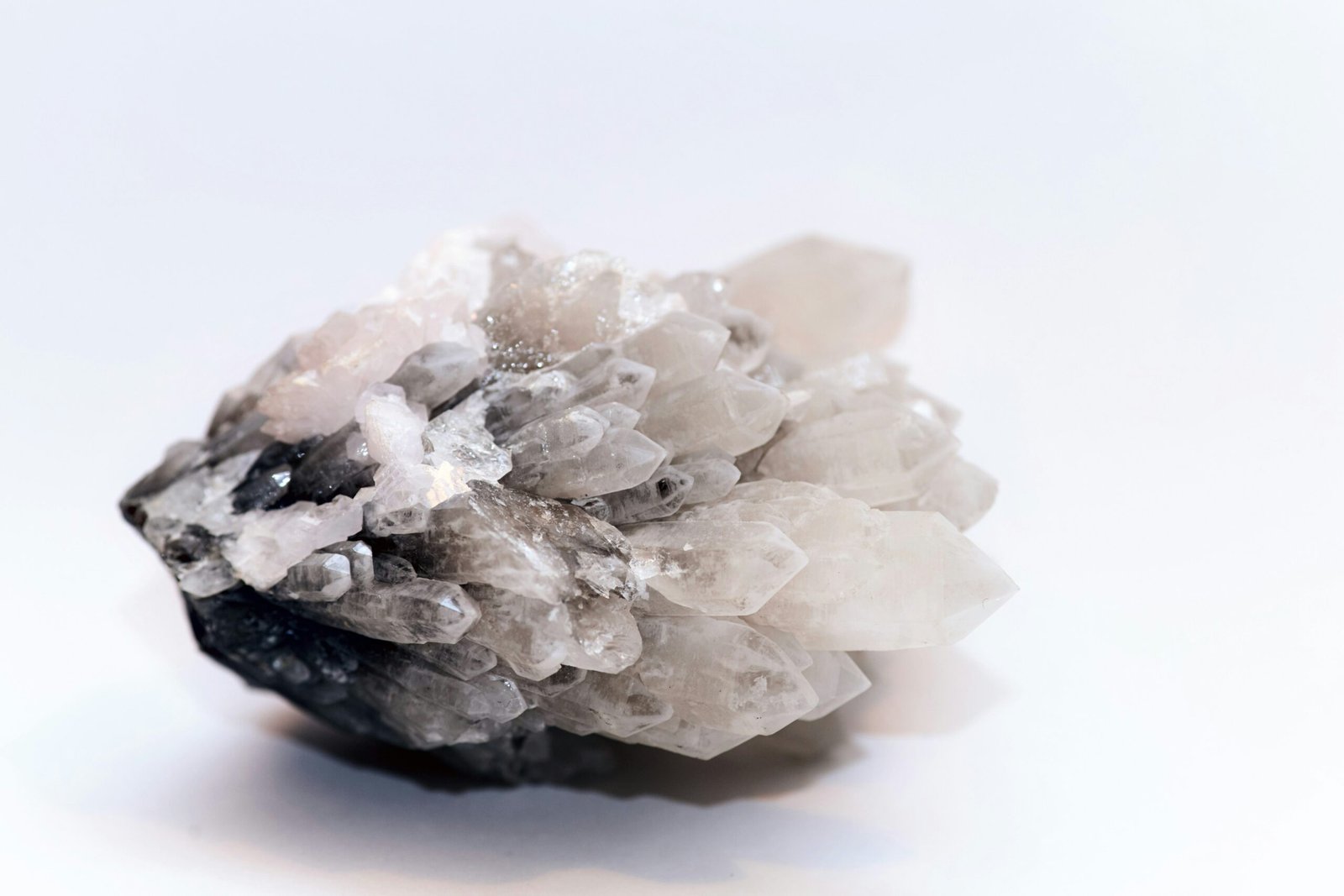Understanding the Price of Quartz Crystals: Factors and Trends
Introduction to Quartz Crystals
Quartz crystals, composed primarily of silicon dioxide (SiO₂), are among the most abundant minerals on Earth. These crystals are renowned for their distinct physical properties, including their hardness, clarity, and piezoelectric characteristics. The hexagonal crystal structure contributes to their optical and mechanical stability, making them highly sought after in various applications.
In the electronics industry, quartz crystals play a critical role. Their piezoelectric properties enable them to oscillate at precise frequencies, which is essential for the functioning of electronic devices such as watches, clocks, radios, and computers. This precise frequency control is indispensable for maintaining accurate time and stable communication signals.
Beyond electronics, quartz crystals hold a prominent place in the jewelry industry. With their natural clarity and range of colors, they are fashioned into various ornamental pieces. Quartz varieties like amethyst, citrine, and rose quartz are particularly popular, each valued for its unique aesthetic appeal.
In the realm of metaphysical markets, quartz crystals are revered for their supposed healing properties and spiritual significance. Many believe that different types of quartz can influence energy fields, promote mental clarity, and enhance meditation. This belief has fueled a steady demand for quartz crystals among practitioners of alternative medicine and spiritual enthusiasts.
The historical use of quartz crystals dates back to ancient civilizations. The Greeks and Romans used quartz in various tools and adornments, while indigenous cultures around the world have long attributed mystical properties to these crystals. Over the centuries, the versatility and allure of quartz have only grown, cementing its status as a material of both practical and ornamental value.
Today, the popularity of quartz crystals continues to rise, driven by advancements in technology, a burgeoning interest in natural health remedies, and the timeless appeal of fine jewelry. Understanding the factors that influence the price of quartz crystals requires a foundational knowledge of their properties and applications, setting the stage for a deeper exploration of market dynamics.
Types and Grades of Quartz Crystals
Quartz crystals are diverse and multifaceted, with variations in type and grade significantly influencing their market price. Broadly, quartz crystals can be categorized into two primary types: natural and synthetic. Natural quartz crystals are formed through geological processes over millions of years, making them highly prized for their unique formations and rarity. Synthetic quartz, on the other hand, is created in controlled laboratory environments using the hydrothermal method. While synthetic quartz boasts consistency and purity, it typically commands a lower price than its natural counterpart due to its artificial origin.
Within these categories, quartz crystals are further stratified into different grades: high-grade, mid-grade, and low-grade. High-grade quartz crystals are the most sought-after, characterized by exceptional clarity, minimal inclusions, and vibrant color. These crystals are often used in high-end jewelry and specialized industrial applications where perfection is paramount. Mid-grade quartz, while still of good quality, may exhibit minor inclusions or less intense coloration, making it suitable for a broader range of uses, including decorative pieces and medium-tier jewelry. Low-grade quartz, which might display visible inclusions or a lack of luster, is generally used in bulk applications such as countertops or construction materials.
The criteria for grading quartz crystals are stringent and multifaceted. Clarity is a paramount factor—crystals with fewer inclusions and higher transparency are more valuable. Size also plays a crucial role; larger crystals, especially those with high clarity, command premium prices. Color is another critical criterion; vibrant hues such as amethyst (purple) or citrine (yellow) significantly enhance a crystal’s appeal and market value. Additionally, the presence of unique formations or patterns, such as phantom inclusions or rutilated strands, can elevate a crystal’s grade and desirability.
Understanding the types and grades of quartz crystals is essential for both consumers and industry professionals. This knowledge not only aids in making informed purchasing decisions but also provides insight into the intricate factors that influence the pricing and valuation of these remarkable geological formations.
When evaluating the price of quartz crystals, several factors come into play, significantly influencing their market value. One of the primary determinants is the quality of the crystal. Higher quality quartz crystals, characterized by their clarity, lack of inclusions, and overall aesthetic appeal, command higher prices. Inclusions or impurities within the crystal can detract from its visual beauty and, consequently, its market value.
Rarity is another critical factor; rare quartz varieties such as ametrine or rose quartz can be significantly more expensive than more commonly found types. Size also plays a crucial role in pricing. Larger quartz crystals are generally more valuable, not only because they are rarer but also due to the increased difficulty and cost associated with mining and transporting them.
Color is an essential attribute that influences quartz crystal prices. While clear quartz is relatively common, colored varieties such as amethyst or citrine are more sought after and thus more expensive. The intensity and uniformity of the color can further affect the price, with deeper and more consistent hues being more highly prized.
The origin of the quartz crystal can also impact its price. Crystals from well-known locations, such as Herkimer diamonds from Herkimer County, New York, or amethyst from Brazil, often fetch higher prices due to their reputation and perceived quality. Additionally, crystals sourced from ethically and sustainably managed mines may command a premium, reflecting the growing consumer preference for responsibly sourced gemstones.
Market demand is a dynamic factor affecting quartz crystal prices. Trends in jewelry, home décor, and even metaphysical practices can shift demand, influencing prices accordingly. High demand for specific types of quartz can lead to price increases, while lesser demand can result in lower prices.
Lastly, the processing and treatment of quartz crystals can influence their price. Untreated, natural crystals are generally more valuable than those that have been artificially enhanced or treated. Treatments such as heating or irradiation, although they can improve the visual appeal of a crystal, often lower its market value when compared to natural, untreated specimens.
Market Trends and Price Fluctuations
The quartz crystal market has experienced various trends and price fluctuations over the years, influenced by a myriad of factors including fashion trends, technological advancements, metaphysical beliefs, and global economic conditions. The price of quartz crystals is notably responsive to shifts in consumer preferences, particularly in the jewelry sector. For instance, the growing popularity of minimalist and bohemian styles has led to an increased demand for raw and uncut quartz crystals, which often command higher prices due to their perceived authenticity and aesthetic appeal.
Technological advancements have also played a significant role in shaping the quartz crystal market. Innovations in synthetic quartz production have made it possible to produce high-quality crystals at a lower cost, thereby impacting the prices of natural quartz. However, despite the availability of synthetic alternatives, natural quartz crystals continue to hold substantial value, especially among collectors and enthusiasts who prioritize natural origin and unique formations.
Metaphysical beliefs surrounding quartz crystals further contribute to market dynamics. Quartz is often associated with healing properties, spiritual growth, and energy amplification, making it highly sought after in the wellness and holistic health communities. The rising interest in alternative medicine and spiritual practices has therefore led to a steady increase in demand and, consequently, the price of quartz crystals.
Global economic conditions also significantly influence the quartz crystal market. Economic downturns can lead to reduced consumer spending on non-essential items, including gemstones and crystals. Conversely, periods of economic growth often see an uptick in luxury spending, thereby driving up the prices of high-quality quartz crystals. Additionally, geopolitical factors and trade policies can affect the supply chain, causing price volatility.
Overall, the quartz crystal market is characterized by a complex interplay of various trends and factors. Understanding these elements is crucial for stakeholders, including consumers, collectors, and industry professionals, to navigate the market effectively and make informed decisions.
How to Buy Quartz Crystals: A Guide for Consumers
When venturing into the market for quartz crystals, it is essential to understand where to buy, what to look for, and how to ensure you are getting a fair deal. The first step is identifying reputable dealers. Established vendors, whether online or in physical stores, often provide certification of authenticity, which is crucial for ensuring the quality of your purchase. Online marketplaces like Etsy or eBay can also be viable options if the sellers have high ratings and positive reviews from previous buyers.
Quality is a pivotal factor when purchasing quartz crystals. Examine the crystal for clarity, color, and overall appearance. High-quality quartz crystals are generally clear with minimal inclusions or fractures. The presence of unique formations or rare colors can also indicate higher value. When buying in person, holding the crystal up to the light can help you better inspect its clarity and structure.
Authenticity is another crucial aspect. Be wary of synthetic or treated quartz crystals being sold as natural ones. Authentic quartz crystals typically have natural imperfections and variations, whereas synthetic ones may appear too flawless or uniform. Asking the seller for details about the crystal’s origin and any treatments it may have undergone can provide additional assurance of its authenticity.
Negotiating prices is a skill worth honing. Researching current market prices and having a clear understanding of what you are willing to pay can give you leverage in negotiations. Do not hesitate to ask for discounts, especially if you are purchasing multiple items or higher-value pieces. However, be mindful that extremely low prices can sometimes indicate lower quality or inauthentic products.
Lastly, understanding the return policies of the seller is paramount. Reputable dealers will offer clear return policies that allow you to return or exchange the crystal if it does not meet your expectations. Always read the fine print and ensure you are comfortable with the terms before finalizing your purchase.
Investment Potential of Quartz Crystals
Quartz crystals have garnered attention not only for their aesthetic and metaphysical properties but also as a potential investment option. When comparing quartz crystals to more traditional investments such as stocks, bonds, or real estate, several unique factors come into play that can make them a viable and attractive alternative.
One of the primary factors contributing to the investment potential of quartz crystals is market stability. Unlike stocks or bonds, which can be highly volatile and subject to market fluctuations, the value of quartz crystals tends to be more stable. This stability is largely driven by the consistent demand from both collectors and industries that utilize quartz in various applications, from electronics to jewelry.
Rarity is another critical aspect to consider. While quartz itself is relatively abundant, high-quality, gem-grade quartz crystals are much rarer. These rare specimens are often the ones that appreciate significantly in value over time. Investors who can identify and acquire such high-quality crystals may see substantial returns on their investment. Factors such as clarity, size, color, and the presence of unique inclusions can all contribute to a crystal’s rarity and, consequently, its value.
The potential for appreciation in value is also a noteworthy consideration. As with any collectible asset, the value of quartz crystals can increase over time, especially as they become more sought after by collectors and industries. Historical data shows that well-maintained, high-quality quartz crystals have appreciated in value, making them a sound long-term investment. Moreover, the growing interest in alternative investments has led to an increase in the demand for these crystals, further driving their value upwards.
In summary, quartz crystals present a unique and potentially lucrative investment opportunity. Their market stability, rarity, and potential for value appreciation make them a worthy consideration for investors looking to diversify their portfolios. As with any investment, thorough research and careful selection are essential to maximize returns and ensure the acquisition of high-quality assets.
Ethical and Environmental Considerations
When examining the price of quartz crystals, it is imperative to consider the ethical and environmental ramifications associated with their extraction and trade. The mining of quartz crystals, like many other natural resources, can have significant impacts on the environment and the communities involved in the extraction process. Sustainable mining practices are becoming increasingly important, as they aim to minimize environmental damage while ensuring that local communities benefit from the industry.
Sustainable mining practices include measures such as reducing water usage, preventing soil erosion, and rehabilitating mining sites post-extraction. These practices not only help in preserving the local ecosystems but also ensure that the mining areas can be restored for future use. By supporting companies that engage in sustainable mining, consumers can contribute to reducing the environmental footprint of quartz crystal extraction.
Fair trade is another crucial aspect of the ethical considerations surrounding quartz crystals. Fair trade initiatives ensure that miners receive fair wages and work under safe conditions. This is particularly significant in regions where labor exploitation and unsafe working conditions are prevalent. Supporting fair trade quartz crystals helps promote better living standards for miners and their families, while also ensuring that the products are sourced responsibly.
The environmental impact of quartz extraction is multifaceted. From habitat destruction to water pollution, the effects can be far-reaching. Therefore, it is essential for consumers to be aware of these issues and make informed choices. Companies committed to ethical sourcing often provide transparency about their mining practices, allowing consumers to identify ethically sourced crystals more easily.
Identifying ethically sourced quartz crystals can be achieved by looking for certifications and conducting research on the suppliers. Certifications such as Fair Trade and those from environmental organizations can serve as reliable indicators of responsible sourcing. Additionally, purchasing from reputable sellers who prioritize ethical and sustainable practices can help ensure that the quartz crystals are sourced in a manner that respects both people and the planet.
Future Outlook for Quartz Crystal Prices
The future of quartz crystal prices is poised to be influenced by a multitude of factors, with technological advancements playing a pivotal role. As technology continues to evolve, the demand for high-purity quartz crystals in various applications, including electronics, telecommunications, and renewable energy, is anticipated to rise. The miniaturization of electronic components and the expansion of 5G networks, for instance, require high-quality quartz crystals, which could drive up prices due to increased demand.
Changes in consumer preferences are another critical factor. As sustainability becomes a more significant concern for consumers, there may be a shift towards environmentally friendly mining practices and the sourcing of quartz crystals. This shift could lead to higher production costs, which might be reflected in the market prices. Additionally, the growing popularity of quartz crystals in the wellness industry and their use in decorative items and jewelry could further influence market dynamics.
Potential new sources of quartz could also impact future prices. Advances in mining technology may uncover new deposits of high-quality quartz, potentially stabilizing or even reducing prices. However, the environmental and regulatory challenges associated with new mining projects could offset these benefits. Market forecasts suggest that while new sources may alleviate some supply constraints, the overall trend is likely to see a gradual price increase due to rising demand.
Expert opinions on the market outlook for quartz crystals vary. Some analysts predict a steady rise in prices, driven by technological advancements and consistent demand growth. Others suggest that market volatility could result from geopolitical factors and trade policies affecting the global supply chain. Despite these varying perspectives, there is a consensus that quartz crystal prices will remain influenced by a complex interplay of supply and demand dynamics.






